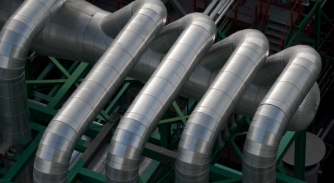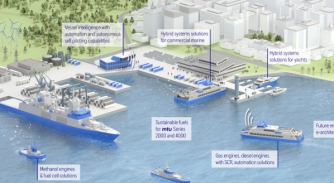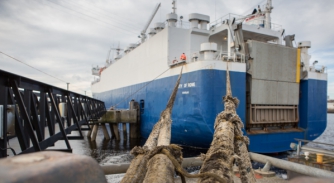Offset and match
Offsetting in the Superyacht Industry is a complex issue and one that may still have a part to play on the path to carbon neutrality…
As global efforts to mitigate environmental impacts intensify, the concept of 'carbon offsetting' has become prominent in the conversation. Although the principle of offsetting holds the promise of reducing our carbon footprint, its practical application has led to several misunderstandings and instances of misuse. Some argue it's a substantial step towards sustainability; others see it as mere 'greenwashing' that distracts from the larger environmental issues.
At its core and in an ideal world, the process of effective offsetting should first require the reduction of a carbon footprint as much as possible. The remaining unavoidable carbon emissions are then offset through the purchase of certified carbon credits. Each carbon credit represents a certificate for the reduction of one tonne of carbon from the atmosphere. There are two primary types of carbon credits:
Carbon Avoidance: These credits support projects designed to prevent future emissions. Examples include initiatives promoting renewable energy.
Carbon Removal: These involve the removal of carbon from the atmosphere through natural or technological means.
These credits are generated by a diverse range of entities including farmers, landowners, NGOs, and project developers engaged in reforestation, energy efficiency, and renewable energy efforts. Once purchased, a carbon credit is registered with a dedicated ledger that records its ownership, sale, and retirement. This registry can be managed by certifying bodies or independent third-party entities. All projects are audited by independent bodies before any certification is issued.
Challenges presented by carbon offsetting:
Despite being a promising avenue, carbon offsetting is still in the early stages of implementation, and the efficiency and authenticity of many efforts have been questioned. The absence of a governing body has often led to discrepancies in methods at almost every stage of the process. Some unscrupulous actors have also exploited this regulatory void, selling 'bad credits', a situation exemplified by the recent controversy involving carbon registry Verra.
Much like ticket reselling, third parties can also take a cut and resell credits, which reduces funding for sustainability projects and potentially increases atmospheric carbon. This issue stems from the profit-driven nature of offsetting. A critical question arises: Should the priority be a profitable business or the reduction of atmospheric carbon?
Additionally, there is significant debate over the methods used to generate carbon credits. Controversies surround certain practices like REDD+ credits, which are generated by preventing deforestation, overuse of tree planting, and the geographical location and nature of funded projects.
A major concern with carbon offsetting is its misuse as a 'get-out-of-jail-free' card for continuous carbon emissions. Without stricter guidelines and regulations, there is enough ambiguity that companies can take advantage of.
For instance, Bentley's presentation at The Superyacht Forum in 2022. The company's slides showed a '99.5 per cent reduction' in CO2 emissions per vehicle during the production process. An impressive figure, but one with small print stating that all of this 99.5 per cent was via offsetting. Still a positive step, but not quite the same as it looked at first glance.
Implications for the superyacht industry:
Given the significant and often unavoidable carbon emissions associated with the yachting industry — from operational emissions to construction and raw material extraction — there is a growing interest in offsetting. While it comes with many issues to navigate, it may offer benefits if implemented correctly.
Accurately assessing a yacht's carbon footprint is, once again, an invaluable exercise. Understanding and monitoring environmental impacts is a crucial first step in addressing carbon emissions, and fortunately, there are industry efforts underway to do just this. Properly conducted and regulated offsetting can potentially render the yachting industry carbon-neutral. Given the industry's substantial financial resources, funding carbon offset projects could also aid global sustainable development efforts.
However, a degree of scepticism is necessary. Offsetting may divert funds from essential fundamental changes to reduce the industry's overall environmental footprint. It should only be used as a secondary tool after making significant strides in reducing carbon emissions. The reality is that carbon offsetting can provide only a fraction of the necessary reductions required to limit global heating to within 1.5 degrees Celsius.
In the quest for a sustainable future, the superyacht industry must tread cautiously. Offsetting holds potential, but it is not a panacea for the challenges of climate change. A concerted effort towards genuine carbon emissions reduction must remain the primary goal. Only then should offsetting be considered a supplementary tool in our environmental strategy.
NEW: Sign up for SuperyachtNewsweek!
Get the latest weekly news, in-depth reports, intelligence, and strategic insights, delivered directly from The Superyacht Group's editors and market analysts.
Stay at the forefront of the superyacht industry with SuperyachtNewsweek
Click here to become part of The Superyacht Group community, and join us in our mission to make this industry accessible to all, and prosperous for the long-term. We are offering access to the superyacht industry’s most comprehensive and longstanding archive of business-critical information, as well as a comprehensive, real-time superyacht fleet database, for just £10 per month, because we are One Industry with One Mission. Sign up here.
Related news

Biofuel plant to open in Spain
Mediterranean capacity of 2nd gen and advanced biofuels to increase with petrochemical giant Repsol to start production at Cartagena facility
Business

CSE and WRF present sustainability framework
The Center for Sustainability and Excellence (CSE) in collaboration with the Water Revolution Foundation (WRF) create Sustainability Reporting Guidelines
Crew

Rolls Royce to present roadmap to net zero
The seminar, at SMM Hamburg 6-9 September, will cover sustainable fuels, alternative propulsion systems and intelligent ship automation
Technology

Straight to the source
How can The National Grid and UK commercial ports inform the superyacht industry's decarbonisation strategy?
Technology

Defining sustainability - EU Taxonomy Regulation
A profound conversation with Dr Vienna Eleuteri, initiator & vice chair of Water Revolution Foundation
Business
Related news
Biofuel plant to open in Spain
3 years ago
CSE and WRF present sustainability framework
3 years ago
Rolls Royce to present roadmap to net zero
3 years ago
Straight to the source
4 years ago
Defining sustainability - EU Taxonomy Regulation
4 years ago
NEW: Sign up for
SuperyachtNewsweek!
Get the latest weekly news, in-depth reports, intelligence, and strategic insights, delivered directly from The Superyacht Group's editors and market analysts.
Stay at the forefront of the superyacht industry with SuperyachtNewsweek



